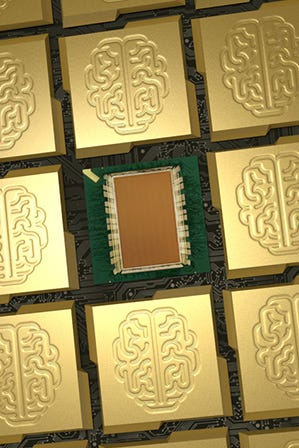The Neverending Search for Brain-Inspired Chip Technology
October 15, 2015
Scientists continue to make progress in the field of neural-inspired computer chips, which could ultimately lead to the development of novel neural networks and improve the treatment of traumatic brain injuries.
Kristopher Sturgis
|
The TrueNorth chip designed by IBM. |
For many years, advances in the field of neural network technology have been considered the stuff of science fiction. However recently, several research endeavors have led to some exciting advancements that may have brought us closer to the idea of actual brain-chip technology than ever before.
Last year IBM introduced a chip designed to operate like the neurons and synapses in the brain, a development aimed at making mobile devices more efficient when it comes to tasks that are easy for brains to accomplish, but difficult for computers. Tasks like speech recognition and image interpretation could function on a much higher level, enabling users to verbally command and communicate with their devices seamlessly.
The chip, known simply as TrueNorth, is roughly the size of a postage stamp, and contains one million silicon "neurons" with 256 million connections between them -- much like the synapses that link the neurons in the human brain. The technology consumes over 1000 times less power than a conventional processor, and its network of neurons can be specifically programmed to perform different tasks. IBM has already begun work on a next generation model, and will be looking to commercialize the technology and incorporate the chip in anything from smartphones to machinery and vehicles.
IBM's introduction of TrueNorth serves as one of the first installments of neural network technology, and has opened the door to all kinds of possibilities within the realm of brain-chip development. Just recently the research arm of the U.S. Department of Defense known as DARPA reportedly began testing a chip that can be implanted into the brains of soldiers. The chip could serve as a boon for soldiers who suffer from traumatic brain injury, as it was designed to assist in cognitive functioning.
Traumatic brain injuries have become a serious source of disability over the years for soldiers returning from military service. Just last year DARPA announced their Restoring Active Memory (RAM) program, a research endeavor created to accelerate the development of fully implantable neural-interface medical devices. The group projected that within 5 years time they could develop an implantable brain chip that could assist in restoring lost memories in patients suffering from traumatic brain injuries.
Projects like the TrueNorth chip and the RAM program are just the latest in the quest to develop brain-chips that not only understand the human brain at a higher level, but can function and operate in tandem with the brain to create a new wave of neural network technologies that can enhance the world around us. Even Google is working on next gen neural network apps to enhance everyday gadgets, and link them without the need of a network for the devices to communicate.
As it appears, the future looks bright when it comes to neural network technologies -- a field that could soon transform smart gadgets into brilliant ones.
Learn more about cutting-edge medical devices at Minnesota Medtech Week, November 4-5 in Minneapolis. |
Like what you're reading? Subscribe to our daily e-newsletter.
About the Author(s)
You May Also Like



